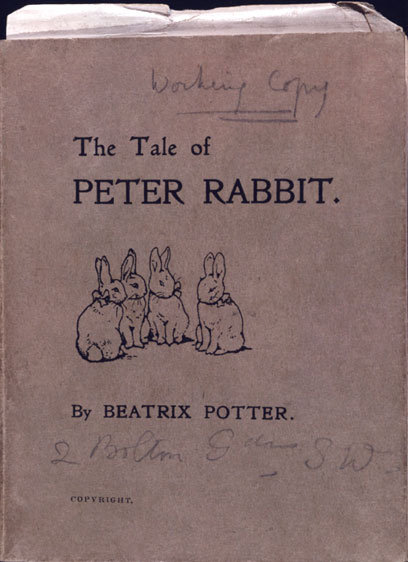Peter Rabbit
dal 3/7/2010 al 7/1/2011
Segnalato da
3/7/2010
Peter Rabbit
Victoria & Albert Museum, London
The tale of The Tale will draw on the collections of both the V&A and Frederick Warne to trace the story of Peter Rabbit from its beginnings as an illustrated letter in 1893 to its publication by Frederick Warne & Co. in 1902, and beyond. For the first time, the complete extant original illustrations from the book will be shown in sequence alongside the text of the story.

Beatrix Potter conceived her tale of Peter Rabbit on 4 September 1893 in an illustrated letter to Noel Moore, the five-year-old son of her friend and former governess, Annie Moore. Noel was recovering from a bout of scarlet fever so Beatrix amused him with a story based upon her real pet rabbit, Peter Piper: 'I don't know what to write to you, so I shall tell you a story about four little rabbits, whose names were - Flopsy, Mopsy, Cottontail, and Peter…'.
In the following years Beatrix sent other picture letters to Noel and to his brother and sisters, including stories about an 'excessively impertinent' squirrel called Nutkin and a disconsolate frog called Mr. Jeremy Fisher. In 1900 Annie suggested to Beatrix that her picture letters might contain material for several picture books. Fortunately the children had kept their letters safe and Beatrix was able to borrow them to copy and rework her text and illustrations. Noel's story of Peter Rabbit was to become Beatrix's first book.
Beatrix wanted her picture book to be small (to fit a child's hands) and affordable, with a black and white illustration on every page to hold the attention of even the youngest reader. At least six publishers, including Frederick Warne, rejected Beatrix's manuscript, they wanted a larger, more expensive book with colour illustrations. Beatrix, however, was resolute: 'little rabbits cannot afford to spend 6 shillings on one book and would never buy it'. She decided to publish the book herself. On 16 December 1901 Strangeways & Sons printed 250 copies of The Tale of Peter Rabbit with black and white illustrations produced by the Art Reproduction Company of Fetter Lane. Only the frontispieces were printed with the new three-colour-process by Hentschel of Fleet Street. A second edition of 200 copies appeared in February 1902. One copy of Beatrix's privately printed edition contains the following inscription:
'In affectionate remembrance of poor old Peter Rabbit, who died on the 26th of January 1901 at the end of his 9th year … whatever the limitations of his intellect or outward shortcomings of his fur, and his ears and toes, his disposition was uniformly amiable and his temper unfailingly sweet. An affectionate companion and a quiet friend.'
Meanwhile a family friend, Canon Hardwicke Rawnsley (a founder member of the National Trust) encouraged Frederick Warne to reconsider Beatrix's book. On 16 December 1901, as Beatrix celebrated her privately printed edition, Warne wrote to offer terms for the publication of the 'Bunny Book', she would have to cut the text and colour the illustrations.
Beatrix used one of her privately printed editions as a working copy, deleting eleven illustrations and re-writing the text until the book was just thirty-two pages. She was interested in all aspects of the book's production, editing meticulously Warne's proofs for both the text and illustrations and designing the cover, title page and frontispiece. She even made suggestions for the colour of the binding.
Publication began in October 1902 with a first edition of 8000 copies, a further 12,000 copies were printed in November and 8220 copies in December. Within a year Warne was already planning a sixth printing. Beatrix was astonished: 'The public must be fond of rabbits! What an appalling quantity of Peter'. Widely considered to be one of the most popular children's books of all time, The Tale of Peter Rabbit has gone on to sell an astonishing 40 million copies worldwide.
The format of the book has changed considerably since its first printing in October 1902. The text of the first three printings is identical but in the fourth printing of April 1903 Beatrix changed just one word, 'Peter wept big tears' became 'Peter shed big tears'. By August 1903 Beatrix had already published a second book, The Tale of Squirrel Nutkin, with colour endpapers.
In order to accommodate the new endpapers in the fifth and subsequent printings of The Tale of Peter Rabbit Beatrix reluctantly eliminated a further four illustrations and adjusted the text accordingly. Warne introduced white jackets to all the little books during the Second World War but it was not until years later that they became standardised to distinguish them from re-illustrated and pirated editions. The 1987 Original and Authorized Edition of the series featured rephotographed illustrations and green covers under white jackets.
Most recently, Warne redesigned the entire series of little books for the 2002 centenary of The Tale of Peter Rabbit, including a new typeface on cream paper and Beatrix's preferred plain endpapers. Most significantly, Warne restored the four illustrations removed from The Tale of Peter Rabbit in October 1903 and included two further illustrations produced by Beatrix for Warne's first edition but never used. Warne's latest edition of the tale follows 'faithfully Beatrix Potter's intentions while benefiting from advances in modern printing and design techniques.'
This display is supported by Frederick Warne & Co. Ltd.
http://www.peterrabbit.com
Image: Beatrix Potter
Privately printed edition of The Tale of Peter Rabbit
1901
© F. Warne & Co., 2010
Opening july 4th
Victoria & Albert Museum
Cromwell Road - London
Rooms 88a and 90
10.00 to 17.45 daily, 10.00 to 22.00 Fridays
Admission to the V&A is free



